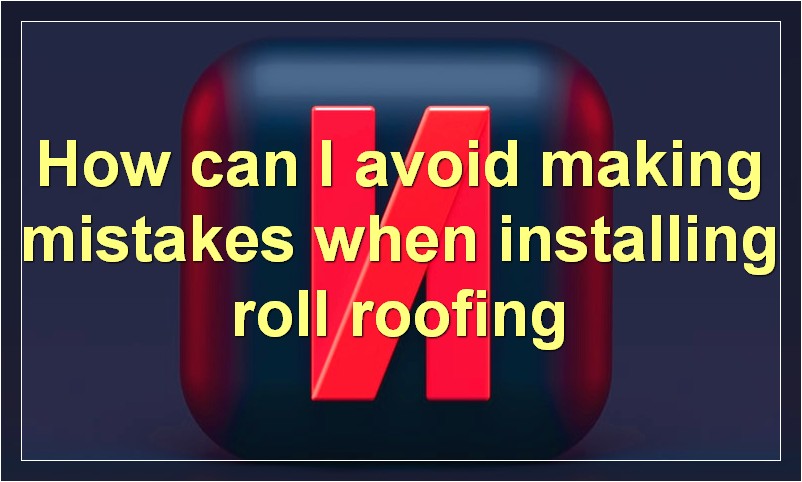There are many benefits to installing roll roofing, including its affordability and ease of installation. This step-by-step guide will show you how to install roll roofing so that you can enjoy these benefits for yourself.
What tools do I need to install roll roofing?
When it comes to roofing, there are a lot of options available on the market. You can choose from asphalt shingles, metal roofing, clay tiles, and even solar panels. But when it comes to durability and cost-effectiveness, roll roofing is hard to beat.
Roll roofing is a type of asphalt-based roofing material that comes in rolls. It’s easy to install, and it’s very affordable. In fact, roll roofing is one of the most cost-effective roofing options available on the market today.
So, if you’re thinking about installing roll roofing, what do you need? Here’s a quick rundown of the tools you’ll need to get the job done:
1. A Ladder: You’ll need a ladder to reach the top of your roof. Make sure the ladder is tall enough to reach the peak of your roof, and that it’s secured at the bottom so it doesn’t slip.
2. A Roll of Roofing: This is the actual roofing material. Roofing rolls come in different widths and lengths, so make sure you choose the right size for your roof.
3. A Utility Knife: You’ll use this to cut the roofing material to fit around chimneys, vents, and other obstacles on your roof.
4. A Pair of Scissors: You’ll need these to trim the edges of the roofing material once it’s installed.
5. A Nail Gun: This is optional, but it makes installation a lot easier. If you don’t have a nail gun, you can use a hammer and nails instead.
6. Roofing Nails: These are specially designed nails that are used for attaching roll roofing. Make sure you get the right type of nails for your particular type of roofing material.
7. A Roll of Flashing: This is optional, but it’s a good idea to install flashing around any vents or skylights on your roof. This will help prevent leaks.
8. Caulking Gun: This is also optional, but it can be helpful for sealing around vents and skylights.
9. Chalk Line: This is used to mark a straight line on your roof before you install the roofing material. This helps ensure that your roofing material is installed evenly.
10. Tape Measure: This is essential for measuring your roof and cutting the roofing material to size.
Now that you know what tools you need, it’s time to get started on your project!
What are the steps involved in installing roll roofing?

Roll roofing is a type of roofing that is easy to install and is available in a variety of colors and styles. It is also one of the most affordable types of roofing on the market. If you are considering installing roll roofing on your home, there are a few things you need to know. Here are the steps involved in installing roll roofing:
1.Measure the area where you will be installing the roll roofing. This will ensure that you have enough material to complete the job.
2.Clean the surface where the roll roofing will be installed. This will help the roofing adhere properly.
3.Remove any nails or other objects that could puncture the roofing.
4.Unroll the roll roofing and cut it to size with a sharp knife.
5.Apply a layer of asphalt cement to the surface where the roll roofing will be installed.
6.Place the roll roofing on the surface and press it down firmly.
7.Apply another layer of asphalt cement over the top of the roll roofing.
8.Use a nail gun to secure the edges of the roll roofing.
9.Trim any excess material with a sharp knife.
10.Enjoy your new roll roof!
What are the benefits of installing roll roofing?
There are many benefits of installing roll roofing. For one, it is much cheaper than traditional shingles, so it is a great option for those on a budget. Additionally, it is much easier to install than shingles, so it is a great option for those who are not experienced in roofing. Finally, it is much more durable than shingles, so it will last longer and require less maintenance.
How can I ensure a proper installation of roll roofing?
Roll roofing is one of the most popular roofing materials on the market today. It is simple to install, durable, and relatively inexpensive. However, there are a few things you need to do to ensure a proper installation.
In this article, we will discuss how to properly install roll roofing. We will cover everything from choosing the right material to preparing the surface. By the end of this article, you should have all the information you need to install your roll roofing correctly.
Let’s get started!
Choosing the Right Material
The first step in installing roll roofing is to choose the right material. There are two main types of roll roofing: asphalt-based and rubber-based. Asphalt-based roll roofing is the most common type. It is made from a fiberglass mat that is coated with asphalt and then topped with mineral granules. Rubber-based roll roofing is less common but growing in popularity. It is made from a synthetic rubber membrane that is reinforced with a fabric backing.
Once you have decided on the type of roll roofing you want to use, you need to select the proper thickness. The thickness of the roll roofing will depend on the pitch of your roof. For example, if you have a low-pitch roof, you will need to use a thicker material than if you have a high-pitch roof.
Preparing the Surface
Once you have chosen the right material and thickness, you need to prepare the surface before you begin installation. The first step is to remove any old roofing material that is still on the surface. This can be done with a shovel or by using a power washer. Next, you need to repair any damage to the surface of the roof deck. This includes replacing any damaged boards and filling any holes or cracks with caulk or another sealant.
After the surface is prepared, you need to measure and cut the roll roofing to size. It is important to make sure that the piece of roll roofing is large enough to cover the entire area plus an additional two feet on each side. Once the piece is cut to size, you are ready to begin installation.
Installation
Installing roll roofing is a relatively simple process. The first step is to peel back the release paper on one end of the roll and adhere it to the edge of the roof deck. Make sure that the adhesive strip is lined up with the edge of the deck and press it into place. Once the first end is secured, unroll the rest of the roll until it covers the entire surface. Use a utility knife to trim off any excess material around the edges.
After the roll roofing is in place, you need to secure it with nails or screws every two feet along all four sides. Finally, apply a bead of sealant around all four edges of the roll roofing to prevent wind uplift and leaks. Allow the sealant to dry according to the manufacturer’s instructions before walking on the surface or applying any weight.
That’s it! You have successfully installed roll roofing.
What are some common mistakes made when installing roll roofing?
When it comes to roofing, there are a lot of things that can go wrong. But when it comes to roll roofing, there are a few common mistakes that people make. Here are four of the most common mistakes made when installing roll roofing:
1. Not Measuring the Roof First
One of the most common mistakes made when installing roll roofing is not measuring the roof first. This is a crucial step in the process, as you need to make sure that you have enough material to cover the entire roof. Without accurate measurements, you could end up with gaps in your roof that will eventually lead to leaks.
2. Not Cleaning the Roof First
Another mistake that people make is not cleaning the roof before they start installing the roll roofing. This is important because you need to remove any debris or dirt that could get in the way of the adhesive strip on the roll roofing. If there’s anything blocking the adhesive, it won’t be able to properly adhere to the roof and could eventually lead to leaks.
3. Not Cutting the Roll Roofing Properly
Another mistake that’s often made is not cutting the roll roofing properly. When you cut the roll roofing, you need to make sure that you leave enough of an overhang so that it can be properly secured to the edge of the roof. If you don’t leave enough of an overhang, it could come loose and cause leaks.
4. Not Securing the Roll Roofing Properly
The final mistake that’s often made is not securing the roll roofing properly. This is usually done by nailing or stapling the roofing into place. But if you don’t do it correctly, the roll roofing could come loose and cause leaks. Make sure that you follow the manufacturer’s instructions carefully so that you can avoid this mistake.
These are just a few of the most common mistakes made when installing roll roofing. By avoiding these mistakes, you can help ensure that your roof will be installed correctly and will last for many years to come.
How can I avoid making mistakes when installing roll roofing?

When it comes to installing roll roofing, there are a few potential mistakes that can be made. To avoid making any of these errors, be sure to follow these tips:
1. Make sure the surface is clean and smooth before beginning. Any debris or imperfections on the surface will show through once the roofing is installed.
2. Be precise when cutting the roofing to size. It’s important to have straight, clean lines so that the finished product looks professional.
3. Don’t overlap the seams of the roofing too much. This can cause problems down the road, so be sure to leave a small gap between each piece.
4. Use a good quality adhesive to secure the roofing in place. This will ensure that it lasts for many years to come.
5. Inspect the roofing regularly after it’s been installed to make sure there are no problems. If you catch any issues early on, they can be easily fixed.
By following these tips, you can avoid making any mistakes when installing roll roofing. Be sure to take your time and do a good job so that you can enjoy a beautiful, long-lasting roof for many years to come.
What are some tips for installing roll roofing?
Roll roofing is one of the most popular and affordable types of roofing on the market. If you’re thinking about installing roll roofing on your home or business, here are a few tips to help you get started:
1. Choose the right product: Not all roll roofing products are created equal. Be sure to do your research and choose a product that is durable and will stand up to the elements.
2. Prepare the surface: The surface needs to be clean, flat, and dry before you can begin installation. Remove any loose debris and make sure the area is free of moisture.
3. Measure and cut: Accurately measure and cut the roll roofing to size. It’s important to have precise measurements to avoid any gaps or overlaps.
4. Install a starter strip: A starter strip helps create a seamless finish and provides additional protection against leaks.
5. Secure the roofing: Use nails or screws to secure the roll roofing in place. Be sure to space the fasteners evenly and drive them into solid wood or sheathing for best results.
6. Finish up: Once the roll roofing is installed, apply a bead of sealant along all the seams. This will help prevent leaks and further protect your home or business from the elements.
Can I install roll roofing myself or do I need professional help?
You might be surprised to know that you can install roll roofing yourself with just a few tools and some basic instructions. However, we still recommend professional help for two reasons. First, installing roll roofing is physically demanding and requires working on your roof, which can be dangerous. Second, professionals have the experience and expertise to ensure that your roof is installed correctly.
How much does it cost to install roll roofing?
It is no secret that a new roof is a big investment. The average cost to install a new roof is $7,000 to $10,000, with most homeowners spending around $8,500 on a 2,000 square foot ranch home. However, the cost of a new roof can range anywhere from $5,000 to $20,000 or more depending on the size and pitch of your roof, the type of roofing materials you select, and whether you need to replace any damaged fascia or soffits.
If you’re thinking about installing roll roofing on your home, you’re probably wondering how much it will cost. Roll roofing is a type of asphalt-based material that is often used on flat or low-sloped roofs. It is available in rolls that are 36 inches wide and usually come in lengths of 50 feet.
The cost of roll roofing will vary depending on the quality of the material and the thickness of the rolls. The thicker the rolls, the more expensive they will be. However, thicker rolls also last longer and provide better protection for your home.
On average, you can expect to pay between $1.50 and $2.50 per square foot for roll roofing material. This does not include the cost of labor or any other materials that may be required for the job such as flashing or underlayment.
If you’re thinking about installing roll roofing on your home, be sure to get several quotes from different contractors before making a decision. The cost of labor can vary significantly from one contractor to the next, so it’s important to get an estimate from each one before making a final decision.
Where can I find more information on installing roll roofing?
Installing roll roofing is a relatively easy and inexpensive way to roof your home. Roll roofing is a type of asphalt-based roofing material that is available in rolls. It is typically used on homes with flat or slightly pitched roofs. Roll roofing is easy to install, and it can last up to 30 years with proper maintenance.
If you are considering installing roll roofing on your home, there are a few things you should know. First, roll roofing is not as durable as other types of roofing, so it may not last as long. Second, roll roofing can be more susceptible to leaks than other types of roofing. Finally, roll roofing can be more difficult to repair than other types of roofing.
If you are still interested in installing roll roofing, there are a few resources that can help you. The first step is to contact your local building department to see if there are any code requirements for installing roll roofing. Next, you can consult a contractor or installation company that specializes in roll roofing. Finally, you can find several do-it-yourself guides online or in home improvement stores.




